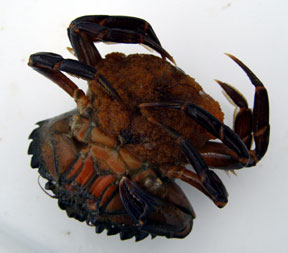 |
 |
|||||||||||||||
|
The green crab, Cancer maenas, is a common resident in the intertidal. Found in tide pools, under seaweed, and in rock crevices this crab is green in color but may have yellow and orange markings on its underside. Green crabs are not a native species of crab. It was first recorded in Long Island Sound, New York in the early-1800s and eventually made its way north. The green crab reached Maine, in the 1950s and has been here ever since. The crab pictured above is a female green crab. That mass she is carrying consists of eggs. Crabs brood their eggs in a mass attached to hair on the female's abdomen. The number of eggs carried can be very large, but depends on the size of the crab. Once developed the eggs hatch into tiny larva called zoea (zo-ee-ah). When the zoea are ready for release, the female waves her abdomen in the water. The crab larvae spend the first few weeks in the water column, while continuing to grow and molt. Eventually they will settle to the ocean bottom looking more like a miniature adult. |
||||||||||||||||
Did you know... |
||||||||||||||||
|
||||||||||||||||

